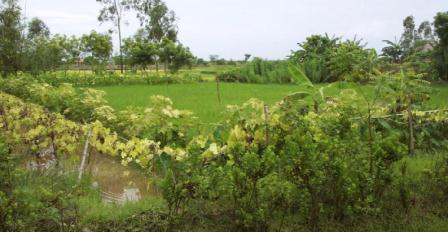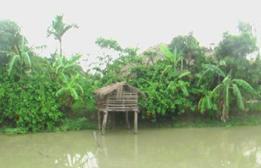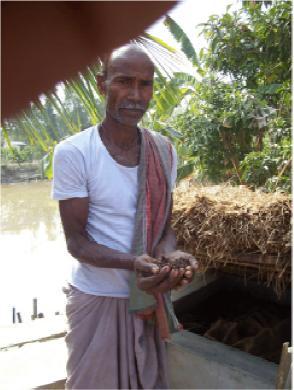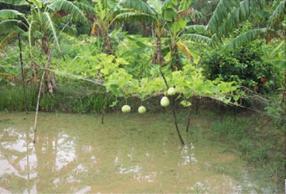Banamali Das, an Integrated Farmer
Banamali Das, an Integrated Farmer

Banamali Das resides in Gayadham village of south24 parganas of West Bengal. He has 5 members in integrated farming. He started in 0.25 acres of land with pond and homestead garden and 0.33 acre of lowland.
This farm is situated in Sunderban delta, hence the soil is clayey and saline. His land was often flooded as it is located beside a river. In the lowland, Banamali used to grow paddy in Kharif and potato and lathyrus in Ravi. In his homestead, he cultivated fruit and leafy vegetables, but that could not reduce his dependence on the market. He reared fish in the pond too, but did not earn much. Cow dung and farmyard manure were used as soil ammendments.
Intervention

A small pond was dug at one corner of his land and the soil obtained was utilized to raise the level of his trial plot. A surrounding trench was also made along the inner boundary of his plot to ensure year round irrigation. The outer border of this plot has some tall trees
like eucalyptus, neem, subabul, rain tree, bamboo etc. The perennial trees surrounding his homestead garden are banana, guava, water apple, sapota, lemon, mango and coconut. Throughout the year he tries 25-30 types of vegetables today, using mixed cropping techniques of various combinations. Banamali Das has recently constructed a Biodigester at his backyard where he has set up a biogas plant to generate biogas and slurry
He has cow, duck and hen as livestock. He adopted suitable complex farming design with rice-fish-duck-azolla during kharif. His trial farm is free from any chemicals. He cultivates fishes such as Rohu, Catla, Bata, Minor carp and catfishes in his pond, which has become more productive.
For fishfeed, he uses only left over of fodder, domestic waste, cow dung and sesame cake. He has 5 cows, 8 ducklings 4 hens and 14 chicks. As fodder he uses hay, grass and various crop residues. For chicken and ducks, he uses rice grains, husk, residues of the paddy harvest and small snails from the pond.

He prepares vermicompost and compost by himself. He also uses sesame cake and graded biogas slurry as organic manure. He prepares mixture of neem extract, garlic paste and kerosene as pest repellent. Usually he keeps most of his seeds from the crops grown in the previous season. Only a few crops that are absolutely seasonal and are mainly cash crops like knolkhol, cabbage and cauliflower are purchased from the local market. He also exchanges his seeds after a certain period of time. His trial plot and homestead garden is spread over a large area and is beautifully managed. He has introduced mixed cropping (with brinjal, radish, water spinach & potato + pumpkin, onion+ basella) in his field. He has a vermicompost pit from where he serves the organic needs of his fields and garden. He has also adopted an integrated farming approach where he uses ducks to aerate his paddy fields, hens to consume the pests in his garden and lets in fingerlings when the paddy fields are flooded.
In his trial plot, the crop combination has increased from monocrop in Kharif 2004 to a combination of 9 crops in Kharif 2005. He has transferred the hencoop on his pond so that the droppings from the hen may directly fall into the pond. Because of the presence of zooplankton & phytoplankton, droppings are a good source of food for the fish.

The banks of the pond are used for growing leafy vegetables like Ipomoea aquatica etc. Out of his total input of Rs. 12235.75/- (excluding internal labour value) the value of internal inputs is Rs. 9497.75/-. This means that approximately 77.62% of the total inputs used is internal. In these last years, the percentage of organic carbon in the soil has increased. If we compare Banamali’s plot with a conventional plot in the context of fossil fuel dependency, we find that Fossil fuel dependency is practically 0(zero) because all variable inputs are produced from within the farm. Most of the labour required in the production process is contributed by the farmer himself and by his family members. However he has planned his farm in such a way that drudgery is reduced. Today Banamali Das manages his farm efficiently and has reaped economic, environmental and social benefits from it. Many farmers, after seeing the success of Banamali, has shifted to
integrated farming, both within the area, and also outside it. Banamali has not only done input substitution and reduced his market dependency but also generated profits from selling considerable amount of output after meeting the necessities of his family.
The practice of integrated organic farming has given his family food security. The considerable extent of integration done in his farm has reduced his dependence on market as his farm inputs are largely being generated in the farm itself.
Source : DRCSC, Kolkata
Last Modified : 3/1/2020
